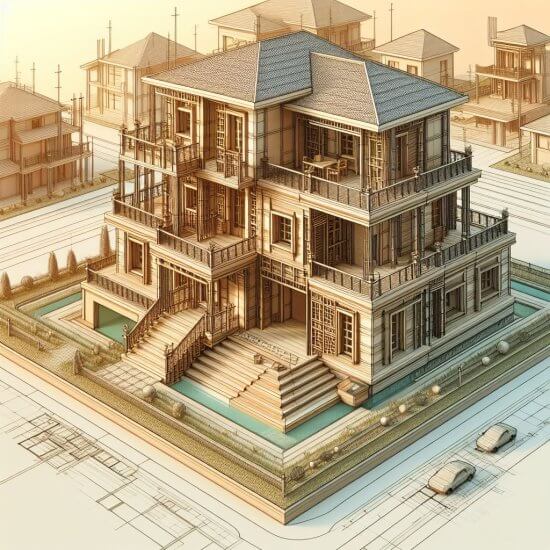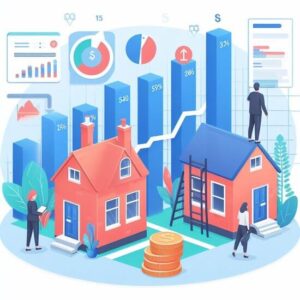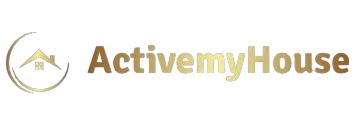Average height of house varies based on the number of storeys. Single-storey houses are 8 to 12 feet tall; double-storey houses have a range of 20 to 25 feet. Triple-storey houses reach heights averaging between 28 to 36 feet. These dimensions reflect current trends in residential construction and urban planning preferences.
Average Height of House
Average Height of House in the UK stands at approximately 8 to 9 meters, encompassing the ground-to-roof measurement. This average varies due to factors like architectural styles and building regulations. In addition, multi-story homes usually rise higher than this average height. The insight into the Average Height of House is significant for urban planning, construction standards, and infrastructure development, offering valuable perspectives on the changing residential landscape in the UK.
1: Single-Storey House

The single-story house design, with an average house height of 8-10 feet, continues to rule UK residential areas. The accessible and open style of these single-story homes appeals to a diverse variety of clients, including the elderly and those with mobility challenges.
2: Double-Storey House

The common type of house is the double-story house, which usually has an average height of house between 19 and 24 feet. Families can live in spacious homes with numerous storeys to accommodate a variety of activities and purposes, from daily living to displaying collections like types of clocks, thanks to this architectural style. In urban and suburban locations, double-story houses help make efficient use of available land.
3: Triple-Storey House

Triple storey houses are a distinctive housing option in the UK, typically featuring an average height of house ranging from 28 to 36 feet. Many of these homes showcase contemporary designs—like modern grey house with black trim while these residences offer extensive living space across multiple levels, accommodating the needs of larger families or individuals seeking ample room for various activities within their home. With their towering presence, triple-story houses contribute to efficient land utilization and are often found in urban and suburban environments throughout the UK.
Factors that impact the average height of house in UK

1: Planning Regulations
Local planning policies and building regulations determine the maximum height limits for residential developments. Stricter rules in conservation areas maintain heritage scale.
2: Land Costs
Height is restricted in high-density urban centers where land costs are high due to space constraints. Suburban or rural builds have more scope for taller builds on larger plots—often with room for landscaping features like a creeping thyme lawn, which adds beauty.
3: Heritage and Character
Period properties in historic districts adhere to the average heights of original structural styles to preserve established streetscapes. New Builds reference context.
4: Property Styles
Architectural styles like bungalows have lower average heights, while mansion blocks reach upper limits. Contemporary designs flex standards.
5: Structural Engineering
Construction methods and materials dictate stable configurations. Taller builds involve added costs for foundations and bracing above norms.
6: Building Code Compliance
Regulations ensure structural integrity and safety aspects like ventilation and lighting within set heights. Specialist signoff is required for variances.
7: Economic Viability
In current markets, extra building costs of heights above average may not yield sufficient returns on investment compared to codes.
8: Lifestyle Preferences
Younger buyers favor open-plan living on multiple floors, whereas downsizers want single-level layouts. Average heights match target demographics.
Does the height of a house impact its value in the UK?

The average top of houses within the UK plays an important function in figuring out belongings values. The common peak of house ceilings inside the UK is around 2.4 meters, or 7.9 feet. However, houses with better-than-common ceilings are better suited to buyers and have a tendency to fetch a better price within the actual estate marketplace.
Properties with higher-than-common house height allow more light into the house and supply an experience of spaciousness. This complements the livability and aesthetic enchantment of the belongings. Buyers are willing to pay a premium for such traits—just as borrowers might prioritize flexible terms when seeking financial solutions like Payday Loans eLoanWarehouse. Data from asset listings and income in the UK show that homes with ceiling heights that are 10 cm or more above the average height of house ceilings command 3-5% higher property values on average compared to others of comparable length, area, and facilities.
At the same time, increasing the height of homes additionally approaches better production prices. This additional funding in building higher might not translate into direct financial returns. The top-quality height might be one that improves livability extensively without making production charges disproportionately higher. In summary, at the same time as average residence peak does affect belongings price, different places and property features also play essential roles, according to housing in UK statistics. An excellent balance of things maximizes returns on investment. The choicest peak should strike a balance between stepped-forward livability and value-effectiveness. If you’re looking to move to a more suitably sized home, you should get a moving cost estimate first to prepare.
The role of architectural styles in average house height in UK

The average height of house and ceilings in the UK varies based on architectural styles. For example, Victorian-style terraced homes from the 1800s typically had lower average heights of around 2.3-2.35 meters due to construction methods at the time. In contrast, Georgian architecture from the early 1900s favored higher ceilings that were closer to the current average height of house ceilings in the UK of 2.4 meters.
Contemporary modern styles built after 2000 often feature above-average heights to maximize sense of space. Some modern exec styles have ceiling heights up to 3 meters high. Contemporary open-plan layouts are better suited to the taller average height of house. This helps prevent feeling cramped.
Older traditional architectural styles likewise influence the average height of UK homes. Tudor beam ceilings tended to be lower, while grander Baroque or Neoclassical designs from the early 1900s involved higher ceiling heights—much like the soaring, elegant proportions seen in today’s Luxury Villas Italy Le Collectionist. Period properties from the 1600s may only have average heights of 2.1-2.2 meters.
Conclusion:
The average height of house varies throughout regions and property sorts. Factors along with planning policies, land expenses (including considerations like how big is an acre in high-demand areas), historical past concerns, property styles, structural engineering, constructing code compliance, financial viability, and way of life preferences impact common residence heights. Architectural styles play a sizable role in determining average house heights, and homes with a higher-than-average height frequently command higher belongings values. While increasing house peak can enhance livability and property fees, it additionally entails better construction prices. The choicest peak should strike a balance between stepped-forward livability and value-effectiveness.


Amazing article 😇